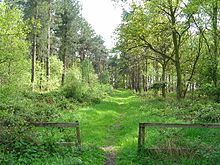Allerthorpe Common facts for kids
| Site of Special Scientific Interest | |

Western entrance to Allerthorpe Common
|
|
| Area of Search | East Riding of Yorkshire |
|---|---|
| Coordinates | 53°55′07″N 0°50′31″W / 53.918504°N 0.842049°W |
| Interest | Biological |
| Area | 22.6 acres (0.091 km2; 0.0353 sq mi) |
| Notification | 1951 |
Allerthorpe Common is a special place for nature in the East Riding of Yorkshire, England. It is a Site of Special Scientific Interest (SSSI) and a nature reserve. This means it is protected because of its important plants, animals, or geology. You can find it near the town of Pocklington.
Contents
History of Allerthorpe Common
How Allerthorpe Got Its Name
Allerthorpe was first mentioned in a very old book called the Domesday Book in 1086. Its name, "Aluuarstorp," means a small village or "thorpe" that belonged to a man named Alfard.
Ancient Times and Early Use
Scientists have studied pollen from the common. They found that plants like heather, birch, and some pine trees have grown here for at least 2,000 years. Long ago, during Anglo-Saxon times, some trees were cut down. This made space for animals to graze. Local people, called commoners, had rights to use the land. They could let their cattle eat grass, cut turf for fuel, and gather wood and gorse for repairs.
Changes Over Time
Between 1750 and 1800, the land around the common was "enclosed." This means it was fenced off and used for farming. As the surrounding farms improved their drainage, the common became drier. In the 1950s, the Forestry Commission bought the land. They drained part of it and planted different types of pine trees in 1963. These included Scots pine, Austrian pine, and Lodgepole pine.
Becoming a Nature Reserve
In 1965, a special area of about 12.6 hectares (about 31 acres) was chosen. It became a Site of Special Scientific Interest (SSSI). This part was set aside as a nature reserve. It was important because it was one of the last areas of natural grassland in the Vale of York.
What is Allerthorpe Common Like?
The Land and Soil
The common sits on sand left behind by ancient rivers and lakes. These were formed about 10,000 to 12,000 years ago, after the last ice age. The soil here is "acidic," which means it has a low pH level. This type of soil creates different kinds of habitats. You can find wet and dry heathland, boggy areas called "mire," grasslands, and woodlands.
Plants of the Common
In the drier parts, you will mostly see heather. Mixed in with it are cross-leaved heath and purple moor grass. In the wetter areas, purple moor grass grows in thick clumps, called "tussocks." You can also find common cottongrass and marsh cinquefoil in the wet, boggy spots. A very rare plant, the marsh gentian, also grows here. It is special because it is not found in many other places in the country.
Animals and Birds
Allerthorpe Common is home to many interesting animals. Several types of birds breed here. These include the nightjar, which is active at night. You might also spot the tree pipit and the whinchat. These birds come to the common to build their nests and raise their young.

